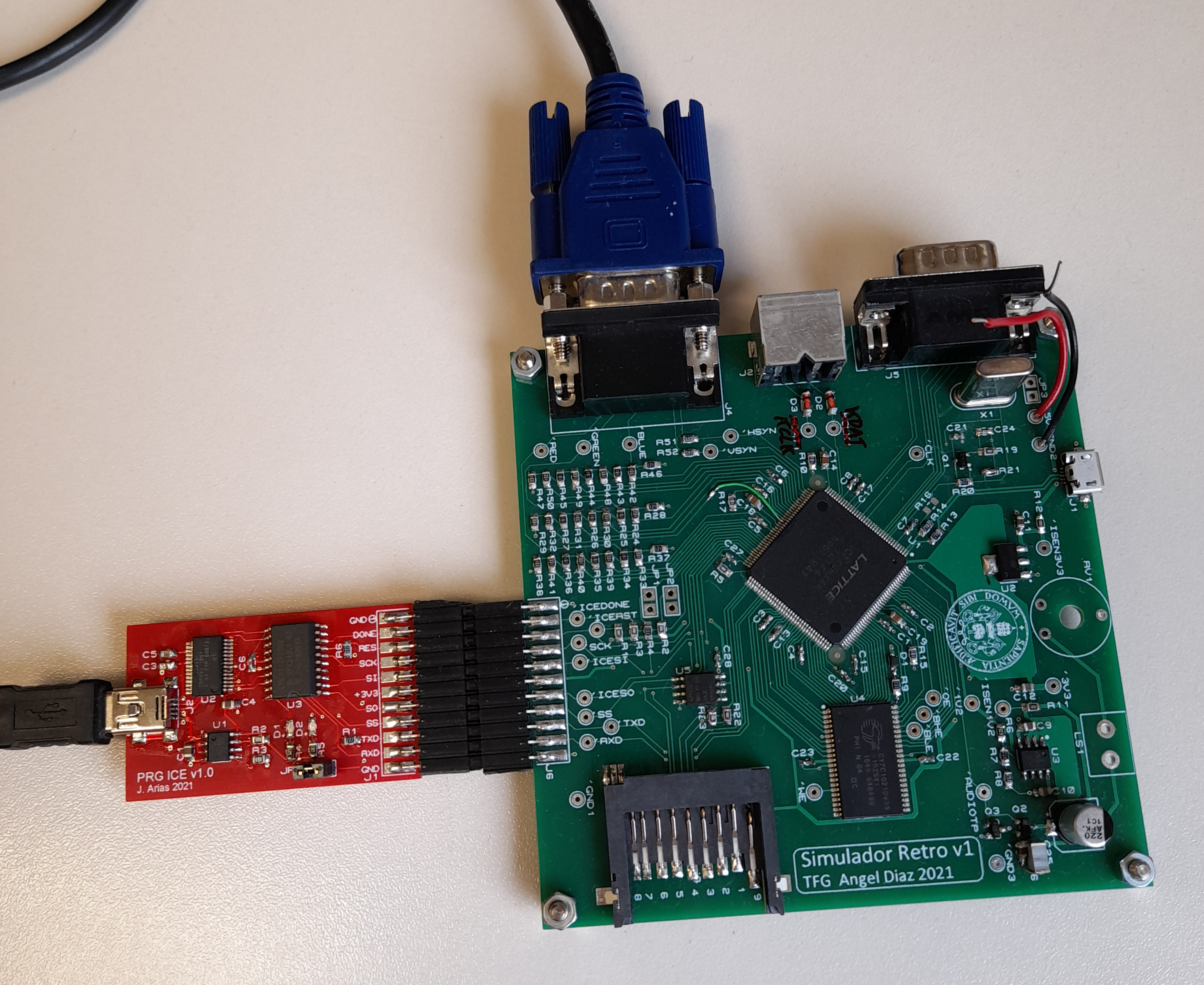
Programming board (red) connected to an
old revision of the SIMRETRO board (green)
SIMRETRO is a board designed by Angel Díaz
under the supervision of Jesús Arias for the hardware emulation of old
8-bit computers and / or arcade machines. It requires an additional
board, PRGICE, for its programming, but then it can run as an standalone
computer.
Features:
- ICE40HX4K FPGA with 7680 logic cells and 16KB RAM
- External SRAM with 128KB and 16-bit busses
- Flash SPI for FPGA configuration and storage
- 16 MHz crystal oscillator
- VGA interface with 4 bit DACs (16 levels for each color component, or 4096 colors)
- PS2 keyboard interface
- Atari style joystick interface. It can also drive a NES game controller
- 1-bit, PWM capable, audio output with integrated amplifier
- SD card connector
- Micro-USB connector for power input.
Hardware Sources (rev.
2.2):
- Schematic: SIMRETRO2_schematic.pdf
- Layout:
- Top side: SIMRETRO2_layout_TOP.pdf
- Bottom side: SIMRETRO2_layout_BOTTOM.pdf
- Gerber files: SIMRETRO2_2 - CADCAM.ZIP
- 3D views SIMRETRO2_3D_1.pdf, SIMRETRO2_3D_2.pdf
New in revision 2.2:
- 4 LEDs
- Reset button plus 2 general purpose buttons
- Separate SPI bus for the SD card
- 3-way jumper for power selection in the Joystick connector.
- 512 KB SRAM supported (the old 128KB is also supported)
- Improved clock oscillator
Hardware Sources (HDMI
version):
- Schematic: SIMRETROH1_schematic.pdf
- Layout:
- Top side: SIMRETROH1_layout_TOP.pdf
- Bottom side: SIMRETROH1_layout_BOTTOM.pdf
- Gerber files: SIMRETRO_H1_0 - CADCAM.ZIP
- 3D views SIMRETROH1_3D_1.pdf, SIMRETROH1_3D_2.pdf
Same as 2.2 revision but with an HDMI connector instead of VGA
Programming Board: PRGICE
Features:
- USB to serial interface to PC, CDC-ACM compatible
- 32-bit ARM cortex-M0 for FPGA configuration and Flash programming
- Provides a serial interface to the PC after programming
- Can power the 3.3V section of the SIMRETRO board from the USB connector
Hardware Sources:
- Schematic: PRGICE10_schematic.pdf
- Layout:
- Top side: PRGICE10_layout_TOP.pdf
- Bottom side: PRGICE10_layout_BOTTOM.pdf
- Gerber files: PRGICE10 -
CADCAM.ZIP
- 3D views PRGICE10_3D.pdf
Firmware for the microcontroller &
linux uploader: lpc11loader.tgz
folder listing: lpc11loader
- An ARM toolchain is required for firmware compilation.
- Now, the frequency of pin 21 can be selected from the command line. It defaults to 12MHz, but it can also be 16MHz. (or in general 48MHz/N, with N integer)